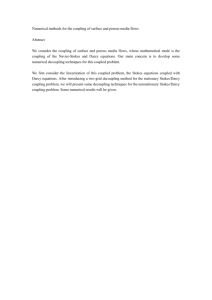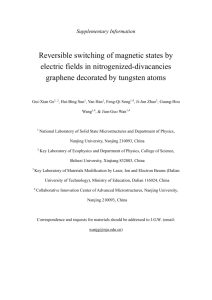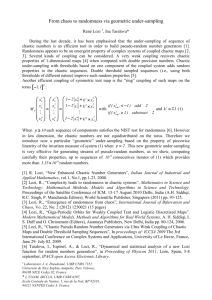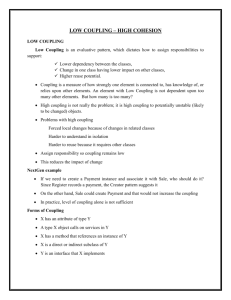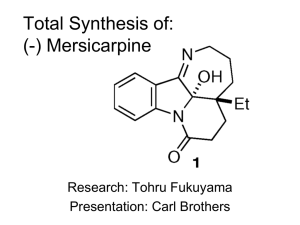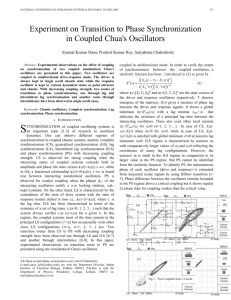Control of Chaotic Dynamics by Linear Resistive Coupling
advertisement
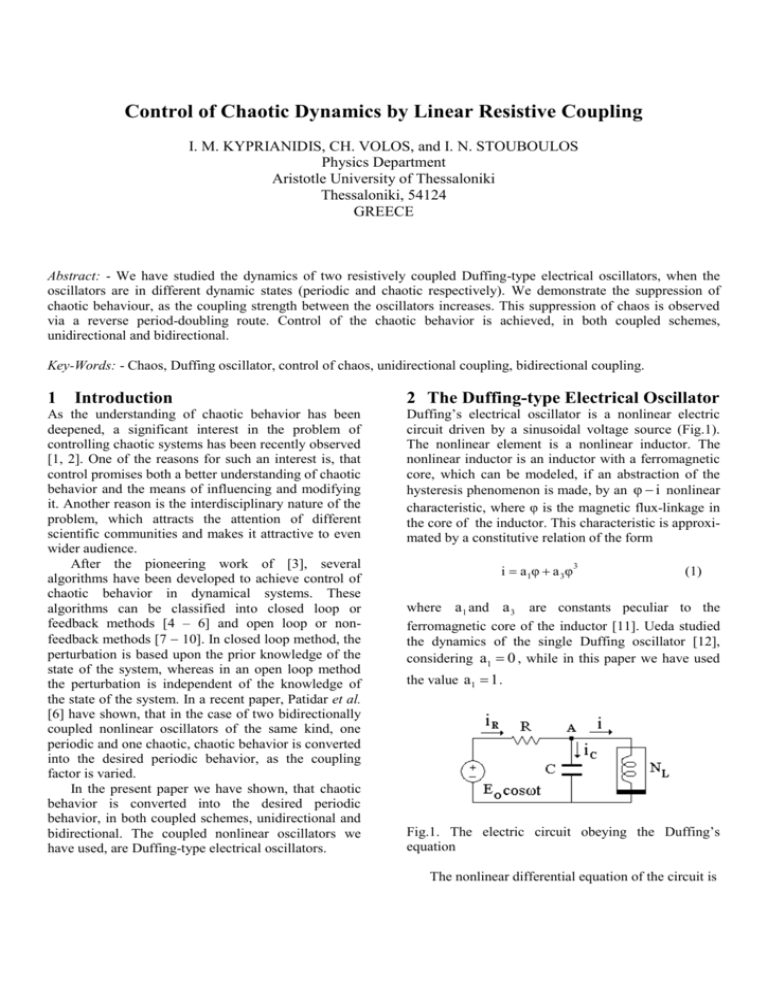
Control of Chaotic Dynamics by Linear Resistive Coupling I. M. KYPRIANIDIS, CH. VOLOS, and I. N. STOUBOULOS Physics Department Aristotle University of Thessaloniki Thessaloniki, 54124 GREECE Abstract: - We have studied the dynamics of two resistively coupled Duffing-type electrical oscillators, when the oscillators are in different dynamic states (periodic and chaotic respectively). We demonstrate the suppression of chaotic behaviour, as the coupling strength between the oscillators increases. This suppression of chaos is observed via a reverse period-doubling route. Control of the chaotic behavior is achieved, in both coupled schemes, unidirectional and bidirectional. Key-Words: - Chaos, Duffing oscillator, control of chaos, unidirectional coupling, bidirectional coupling. 1 Introduction 2 The Duffing-type Electrical Oscillator As the understanding of chaotic behavior has been deepened, a significant interest in the problem of controlling chaotic systems has been recently observed [1, 2]. One of the reasons for such an interest is, that control promises both a better understanding of chaotic behavior and the means of influencing and modifying it. Another reason is the interdisciplinary nature of the problem, which attracts the attention of different scientific communities and makes it attractive to even wider audience. After the pioneering work of [3], several algorithms have been developed to achieve control of chaotic behavior in dynamical systems. These algorithms can be classified into closed loop or feedback methods [4 – 6] and open loop or nonfeedback methods [7 10]. In closed loop method, the perturbation is based upon the prior knowledge of the state of the system, whereas in an open loop method the perturbation is independent of the knowledge of the state of the system. In a recent paper, Patidar et al. [6] have shown, that in the case of two bidirectionally coupled nonlinear oscillators of the same kind, one periodic and one chaotic, chaotic behavior is converted into the desired periodic behavior, as the coupling factor is varied. In the present paper we have shown, that chaotic behavior is converted into the desired periodic behavior, in both coupled schemes, unidirectional and bidirectional. The coupled nonlinear oscillators we have used, are Duffing-type electrical oscillators. Duffing’s electrical oscillator is a nonlinear electric circuit driven by a sinusoidal voltage source (Fig.1). The nonlinear element is a nonlinear inductor. The nonlinear inductor is an inductor with a ferromagnetic core, which can be modeled, if an abstraction of the hysteresis phenomenon is made, by an φ i nonlinear characteristic, where φ is the magnetic flux-linkage in the core of the inductor. This characteristic is approximated by a constitutive relation of the form i a1φ a 3φ 3 (1) where a1 and a 3 are constants peculiar to the ferromagnetic core of the inductor [11]. Ueda studied the dynamics of the single Duffing oscillator [12], considering a1 0 , while in this paper we have used the value a1 1 . Fig.1. The electric circuit obeying the Duffing’s equation The nonlinear differential equation of the circuit is d 2φ a3 If we define, ε 1 dt B 1 dφ φ 2 EO RC d2x dt 2 RC dt a1 C C φ3 RC Eo R , a cos ωt a1 C , b (2) a3 C , and , we take the following Duffing equation ε dx dt ax bx 3 Bcosωt The state equation of the circuit is dx1 x2 dt dx 2 εx 2 ax1 bx13 Bcosωt dt where x1 φ and x 2 υL . (3) Fig.3. Two Duffing circuits unidirectionally coupled via a linear resistor. The state equation of the system of Fig.3 is dx1 (4) The bifurcation diagram of the nonlinear circuit for ω = 0.8, a = 1, b = 1 and ε = 0.180 is shown in Fig.2, giving a clear picture of its dynamics. Three bands of chaotic behavior can be observed, so we will study each chaotic band separately. For B < 19.0 the oscillator remains in a period-1 state. dt dx 2 dt dy1 dt dy 2 dt dt dy1 dt dy 2 dt The system of two identical Duffing circuits unidirectionally or one-way coupled via a linear resistor is shown in Fig.3. The buffer in the branch coupling the two Duffing-type circuits isolates dynamics of the left circuit from the influence of the dynamics of the right circuit. (5) y2 ε ξ+1 y 2 y1 y13 εξx 2 Bcosωt If we remove the buffer, we have the case of bidirectional or two-way coupling. In this case, the state equation of the system is dt dx 2 3 The Coupled Systems εx 2 x1 x13 Bcosωt where x1 = φ1 , x2 = υL1 , y1 = φ2 , y2 = υL2 , a = b =1 and ξ = R/RC is the coupling coefficient. dx1 Fig.2. The bifurcation diagram of the circuit of Fig.1, for ω = 0.8, a = 1, b = 1 and ε = 0.180. x2 x2 ε ξ+1 x 2 x1 x13 εξy 2 Bcosωt (6) y2 ε ξ+1 y 2 y1 y13 εξx 2 Bcosωt 4 Control of Chaotic Dynamics We have studied the dynamics of the coupled systems, as the left circuit (circuit-x) is in a period-1 state, while the right circuit (circuit-y) is in a chaotic state. The coupling coefficient ξ is the control parameter. The two coupled oscillators have the same circuit parameters except the amplitude of the sinusoidal voltage source. The first has amplitude B1 = 2.5 being in a period-1 state, while the second has amplitude B2, which can take different values being in a chaotic state. In Fig.4, the dynamics of the system is shown for B2 = 23.5, as the coupling factor is increased. The system is driven in a period-1 state following a reverse period doubling sequence, in both cases, unidirectional and bidirectional coupling. The same behavior is observed, when B2 = 26.7 (Fig.5), and B2 = 28.5 (Fig.6). (b) Fig. 5. Bifurcation diagrams y1-x1 vs. ξ, for ω = 0.8, ε = 0.180, B1 = 2.5 and B2 = 26.7 [(a) unidirectional (1way) coupling, and (b) bidirectional (2-way) coupling. (a) (a) (b) Fig. 4. Bifurcation diagrams y1-x1 vs. ξ, for ω = 0.8, ε = 0.180, B1 = 2.5 and B2 = 23.5 [(a) unidirectional (1way) coupling, and (b) bidirectional (2-way) coupling. (b) Fig. 6. Bifurcation diagrams y1-x1 vs. ξ, for ω = 0.8, ε = 0.180, B1 = 2.5 and B2 = 28.5 [(a) unidirectional coupling, and (b) bidirectional coupling. (a) For greater values of the amplitude B1 , the dynamics becomes more complex, as the chaotic state is driven to the periodic one. (Figs.79). In Fig.7(a), B1 14.0 , B2 23.5 and 1-way coupling, the chaotic state is driven to a period-1 state for 0.20 ξ 0.30 , and then, as the coupling coefficient is increased, the period-1 state becomes chaotic again 0.30 ξ 0.80 . As the coupling coefficient is further increased, a reverse period doubling sequence is observed and the system is driven to a period-1 state. The same scenario is observed in the case of B1 14.0 , B2 23.5 and 2way coupling (Fig.7b), as well as in the cases of B2 26.7 and B2 28.5 (Figs.8,9). (a) (a) (b) Fig. 8. Bifurcation diagrams y1 x1 vs. ξ, for ω = 0.8, ε = 0.180, B1 = 14.0 and B2 = 26.7 [(a) unidirectional (1-way) coupling, and (b) bidirectional (2-way) coupling. (b) Fig. 7. Bifurcation diagrams y1 x1 vs. ξ, for ω = 0.8, ε = 0.180, B1 = 14.0 and B2 = 23.5 [(a) unidirectional (1-way) coupling, and (b) bidirectional (2-way) coupling. Fig.9(a) (continued) (b) Fig. 9. Bifurcation diagrams y1 x1 vs. ξ, for ω = 0.8, ε = 0.180, B1 = 14.0 and B2 = 28.5 [(a) unidirectional (1-way) coupling, and (b) bidirectional (2-way) coupling. 5 Conclusions In this paper, we have studied the dynamics of two resistively coupled nonlinear Duffing-type electrical oscillators in the case, when the oscillators are in different dynamic states (periodic and chaotic respectively). In this case, control of the chaotic behavior is achieved following a reverse period doubling route. The method is more robust for low values of the amplitude B1 of the voltage source of the periodic oscillator. The proposed control method seems to work well in both coupling schemes, unidirectional and bidirectional. We have checked this method and in other coupled electrical oscillators of the same kind. It seems to work for low dimension oscillators, but it does not always work for higher dimension oscillators [13]. Acknowledgements This work has been supported by the research program “EPEAEK II, PYTHAGORAS II” of the Greek Ministry of Education and E.U. References: [1] Chen, G. and Dong, X., From Chaos to Order: Perspectives, Methodologies and Applications, World Scientific, 1998. [2] Fradkov, A. L. and. Pogromsky, A.Yu , Introduction to Control of Oscillations and Chaos, World Scientific, 1998. [3] Ott, E., Grebogi C. and Yorke J. A., Controlling chaos, Phys. Rev. Lett., Vol.64, 1990, pp. 11961199. [4] Hunt, E. R., Stabilizing high-period orbits in a chaotic system: The diode resonator, Phys. Rev. Lett., Vol.67, 1991, pp. 1953-1955. [5] Roy, R., Murphy, T. W., Maier, T. D., Gills, Z. and Hunt, E.R., Dynamical control of a chaotic laser: Experimental stabilization of a globally coupled system, Phys. Rev. Lett., Vol.68, 1992, pp. 1259-1262. [6] Patidar, V., Pareek, N. K. and Sud, K. K., Suppression of chaos using mutual coupling, Phys. Lett., Vol.A304, 2002, pp. 121-129. [7] Lima, R. and Pettini, M., Suppression of chaos by resonant parametric perturbations, Phys. Rev. A, Vol.41, 1990, pp. 726-733. [8] Fronzoni, L., Giocondo M. and Pettini, M., Experimental evidence of suppression of chaos by resonant parametric perturbations, Phys. Rev. A, Vol.43, 1991, pp. 6483-6487. [9] Rajasekar, S. and Lakshmanan, M., Algorithms for controlling chaotic motion: application for the BVP oscillator, Physica D, Vol.67, 1993, pp. 282300. [10] Kivsar Y. S., Rödesperger, F. and Benner, H., Suppression of chaos by nonresonant parametric perturbations, Phys. Rev. E, Vol.49, 1994, pp. 319324. [11] Hasler, M. and Neirynck, Nonlinear Circuits, Artech House, 1986. [12] Ueda Y., Randomly transitional phenomena in the system governed by Duffing’s equation, Int. J. Non-Linear Mechanics, Vol. 20, 1985, pp. 481491. [13] Kyprianidis I. M., and Stouboulos I. N., Synchronization of two resistively coupled nonautonomous and hyperchaotic oscillators, Chaos Solit. Fract., Vol.17, 2003, pp. 317-325.
